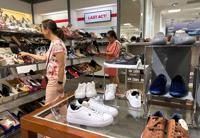(CNN) �� has been a common refrain for a while now.
When economic reports are released that are solid, they have all too often been clouded with concerns that good news for the economy actually means a longer wait before the Federal Reserve rolls out rate cuts.
This week, a string of good news was actually good news: Closely watched inflation gauges showed ; Americans�� financial outlooks in years while their inflation expectations dipped; and, on Friday, US import prices reversed course and fell sharply, adding fuel to the disinflationary fire.
“What we saw in the data is a reaffirmation of the idea that the economy, hiring, inflation are all cooling, which should create the conditions later this year for the Federal Reserve to relax their restrictive policy rate,�� said Joe Brusuelas, principal and chief economist for RSM US. “And long-term interest rates will come down, which means the cost of financing, to purchase a car, a dishwasher or a washing machine or dryer, all will fall.��
He added: “That is good news.��
This week �� with its multiple inflation reports, a Fed meeting, a new central bank rate cut timeline and economic projections, and a slew of ancillary data �� and a foreteller of the economic trajectory.
And it sure did deliver.
On Monday, showed that US consumers reported increased optimism about their current and future financial situation, the stock market and the continued slowing of inflation.
On Tuesday, the National Federation of Independent Business�� optimism index hit the highest level of the year (although firms�� uncertainty rose as well).
But those data points were small fry as to what would come Wednesday.
Inflation as measured by the , with prices holding flat on the month for the first time since July 2022. On an annual basis, consumer prices rose 3.3% from a year earlier, ,
, as did , but a key gauge of underlying inflation also cooled. Core CPI rose just 0.2% for the month (its slowest pace since October of last year), and its annual rate dropped to 3.4%, setting a fresh three-year low.
“The disinflationary trend we saw in 2023 is reasserting itself in that the seasonal noise that we typically see in inflation at the turn of the year was just that, ‘noise,’�� Brusuelas said.
The soft CPI bolstered traders�� expectations that interest rate cuts could now come as soon as September.
The Fed, putting on its hawkish hat, tried to play spoilsport later that afternoon when it held rates at their current levels once again, rate cut for the remainder of the year, down from the last December.
the one-cut plan, especially after the Producer Price Index on Thursday showed that wholesale prices and the BLS�� Import and Export Price Index showed that US imports prices fell 0.4% in May after rising 0.9% in April.
Excluding gas prices, imports still fell 0.3%.
“Everywhere Fed officials look, inflation is now in a cooldown phase after the worrisome first quarter flare-up,�� Chris Rupkey, chief economist at FwdBonds, wrote in a note on Friday. “Fed officials did not see what they were hoping for in the inflation trend when they met earlier this week, but the winds of change are coming for those bearish inflation outlooks as the economy may be slowing more than expected at the end of the second quarter.��
“We would not rule out a first rate cut in September; the market is not,�� Rupkey wrote.
And more good news is likely on the way this next week and later this month, Brusuelas said.
Inflation growing at a slower rate will give Americans more comfort in terms of overall spending, he said, adding that should be on display in next week’s retail sales report. Additionally, the disinflation seen in the CPI and PPI are setting the stage for an equally softer report from the Fed’s favored inflation gauge: The Personal Consumption Expenditures price index, which is due out at the end of the month.
“There’s a real possibility we could see no increase on a monthly basis and that inflation slows into the 2.5% to 2.6% range,�� he said. “At that point, you’re within spitting distance of the Fed’s 2% target, and we have to seriously be talking about rate cuts in the near term.��
The-CNN-Wire
�� & © 2024 Cable News Network, Inc., a Warner Bros. Discovery Company. All rights reserved.














